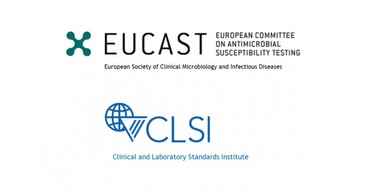You'll receive the latest updates on new standards, guidelines, and educational resources, as well as expert insights to help enhance your laboratory's performance and compliance.
CLSI and EUCAST Release New Guidance on Modifications to Antimicrobial Susceptibility Testing
MALVERN, PA, USA and BASEL, SWITZERLAND — Clinical and Laboratory Standards Institute (CLSI) and the European Committee on Antimicrobial Susceptibility Testing (EUCAST) have jointly published a new document entitled “Modification of Antimicrobial Susceptibility Testing Methods.” This collaborative document provides important guidance for antimicrobial developers on the appropriate use and modification of reference antimicrobial susceptibility testing (AST) methods during the development of new drugs.

MALVERN, PA, USA and BASEL, SWITZERLAND — Clinical and Laboratory Standards Institute (CLSI) and the European Committee on Antimicrobial Susceptibility Testing (EUCAST) have jointly published a new document entitled “Modification of Antimicrobial Susceptibility Testing Methods.” This collaborative document provides important guidance for antimicrobial developers on the appropriate use and modification of reference antimicrobial susceptibility testing (AST) methods during the development of new drugs.
Antimicrobial resistance (AMR) continues to pose a global threat to public health and the timely development of effective new antimicrobial agents and the ability to test them reliably in clinical settings is crucial for global public health. This document, written on behalf of the joint Clinical Laboratory Standards Institute (CLSI) and European Committee on Antimicrobial Susceptibility Testing (EUCAST) New Drug Alternative Methods Ad Hoc Working Group, offers a clear framework to ensure modifications to standard AST methods are scientifically justified and clinically meaningful.
Broth microdilution (BMD) in cation-adjusted Mueller-Hinton broth (CAMHB), as defined by CLSI M07 and ISO 20776-1, is the gold standard reference method for AST. While some novel agents may require method modifications to better reflect their clinical activity, such changes must be rigorously validated. The document warns against attempts to artificially lower minimum inhibitory concentration (MIC) values, emphasizing that such practices are scientifically unsound and potentially misleading.
“While there are certainly instances where modifications of the reference method are necessary, this decision should not be made lightly, and should never be made solely to report a lower MIC,” explains Dr. James S Lewis, II, Oregon Health and Science University Departments of Pharmacy & Infectious Diseases and Co-Chair for the CLSI Subcommittee on Antimicrobial Susceptibility Testing. “In many previous situations, modifying the reference method led to delays in the clinical utilization of a novel agent or has curtailed its clinical use due to complexity introduced by the changes to the standard method. Before making any changes to the reference method a developer should consult with experts in antimicrobial susceptibility testing.”
The document highlights critical considerations for developers, including:
- Initiating AST methods evaluation early in the drug development process
- Using only minimal and scientifically justified adjustments
- Avoiding modifications aimed solely at reducing MIC values
- Consulting with AST experts when encouraging challenges with standard methods
CLSI and EUCAST are actively developing joint guidance to further support harmonized AST method development and modification. In the interim, the organizations strongly recommend adherence to the reference BMD method and close consultation with AST experts to ensure modifications are warranted, effective, and feasible for implementation.
“The development of accurate and practical antimicrobial susceptibility testing methods is critical to ensuring new agents can be reliably implemented in clinical laboratories,” explains Dr. Amy Mathers, University of Virginia Medical School Department of Pathology, and co-Chair of the CLSI Subcommittee for Antimicrobial Susceptibility Testing. “In working closely with EUCAST, we hope the coming guidance will help prevent unnecessary investment in methods that may not be feasible for routine lab use and will ultimately support the broader goal of getting effective therapies to patients efficiently and reliably.”
The full document is now available through CLSI and EUCAST.
******************
About CLSI
Clinical and Laboratory Standards Institute (CLSI) is a global not-for-profit standards development organization that brings together the global laboratory community to develop and promote best practices in laboratory testing. CLSI’s consensus-driven standards improve testing quality, enhance patient care, and facilitate regulatory compliance worldwide. Learn more at clsi.org.
About EUCAST
The European Committee on Antimicrobial Susceptibility Testing (EUCAST) is a standing committee jointly organized by the European Society of Clinical Microbiology and Infectious Diseases (ESCMID), the European Centre for Disease Prevention and Control (ECDC), and other European national organizations. EUCAST sets breakpoints and provides guidance for standardized antimicrobial susceptibility testing methods across Europe and beyond. Learn more at eucast.org.
******************
Media Contacts:
For CLSI:
For EUCAST: